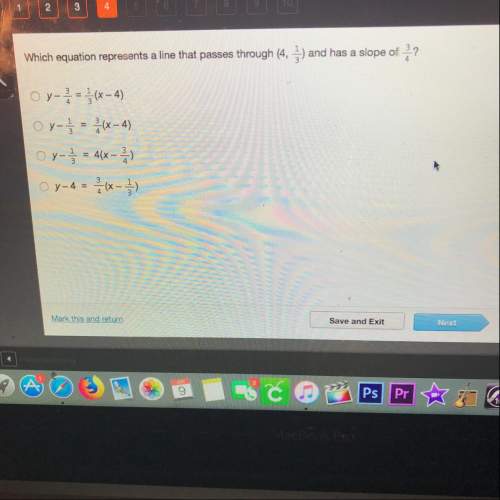
Mathematics, 04.11.2019 21:31, prettydoll19
Aresearcher is interested in the relationship between watching tv and cognitive achievement. cognitive achievement is the ability to learn and remember information. the researcher hypothesized that the more tv a person watched, the lower their performance would be on tests of cognitive achievement. to test this hypothesis, the researcher recruited eighty young adults who live alone. they put a video camera in the living room of the dwelling. the individuals only had a tv in the living room. they taped continuously for one week. multiple research assistants coded how long each participant watched tv. they did not include times when the tv was on but no one was visibly watching it. they did not include times when someone was sitting in front of the tv but not paying attention to the tv. they then had each participant complete a task that measures working memory (one of our cognitive abilities). the task involved reciting the alphabet while also counting (a 1 b 2 c 3 d 4 … etc) up to the total of 52 possible items. performance was coded by the number of correct items completed before an error was made. the researcher found that those who watched more tv performed worse on the task (r = -.31, p< .05).question: part a.1. (state the research question in plain language (i wonder if is related to . state the null hypothesis3. state the research hypothesis4. is the research hypothesis directional or non-directional? part b.1. name the predictor / independent variable2. give the operational definition of the predictor / independent variable.3. evaluate the construct validity of the predictor / independent variable (be sure to consider face, method, and procedural aspects though not all aspects will necessarily need to be discussed; point out strengths and weaknesses of this measure.)part c. is the predictor/ independent variable categorical or continuous? select onepart d. was the predictor/ independent variable manipulated? was it under the experimenter's control? select yes or nopart e. if the predictor / independent variable was measured (not manipulated), how was it measured? select one- observation or- self-report or- physiological or- it was manipulatedpart f. will the researchers be able to determine causation from this predictor / independent variable? select yes or nopart g. considering the previous scenario: 1. name the outcome / dependent variable2. give the operational definition of the outcome / dependent variable.3. evaluate the construct validity of the operational definition for the outcome / dependent variable. (be sure to consider face, method, and procedural aspects though not all aspects will necessarily need to be discussed; point out strengths and weaknesses of this measure.)part h. is the outcome/ dependent variable categorical or continuous? select onepart i. how was the outcome/ dependent variable measured? select one - self-report or - physiological or - observationpart j. summarize the findings. what conclusion can be drawn about the relationship between these variables? be sure to specify whether the relationship is causal or associative. pro tip: your findings are going to look a lot like your hypothesis. to specify the comparison that was drawn, you might state that1. the researchers compared the overall relationship between the two variables(for example: "they correlated how many hours a student studied in a week and their grade on an exam"); or2. the researchers compared frequency (how many people fall into different groups: for example, "they counted how many students got a's, b's, c's, d's and f's on their tests for the students who reported studying less than 5 hours a week and those who reported studying more than 5 hours a week."); or3. the researchers compared group averages. for example, "they compared the average test scores for the students who reported studying less than 5 hours a week to those who reported studying more than 5 hours a week."

Answers: 3
Other questions on the subject: Mathematics

Mathematics, 21.06.2019 17:30, Vampfox
Monthly water bills for a city have a mean of $108.43 and a standard deviation of $32.09. find the probability that a randomly selected bill will have an amount greater than $155, which the city believes might indicate that someone is wasting water. would a bill that size be considered unusual?
Answers: 1

Mathematics, 21.06.2019 18:30, genyjoannerubiera
Isuck at math ; ^; m a student solved this problem and said the answer is 3 feet. chase had a roll of ribbon that contained 7 7/8 feet of ribbon. he cut off one piece that was 3 5/8 feet long and another piece that was 1 1/4 feet from the roll. how much ribbon was left on the roll? is the student's answer reasonable? yes, the answer is reasonable. no, the answer is not reasonable. it should be about 2 feet. no, the answer is not reasonable. it should be about 13 feet. no, the answer is not reasonable. it should be about 4 feet.
Answers: 1

Mathematics, 21.06.2019 19:00, DestyHilBan1183
What are the solutions of the system? solve by graphing. y = -x^2 -6x - 7 y = 2
Answers: 2

Mathematics, 21.06.2019 21:30, coontcakes
Acd that is originally priced at $15.85 red-tagged for the sale. what is the sale price of the cd
Answers: 1
Do you know the correct answer?
Aresearcher is interested in the relationship between watching tv and cognitive achievement. cogniti...
Questions in other subjects:

Mathematics, 08.02.2021 18:10



English, 08.02.2021 18:10


Mathematics, 08.02.2021 18:10




English, 08.02.2021 18:10







